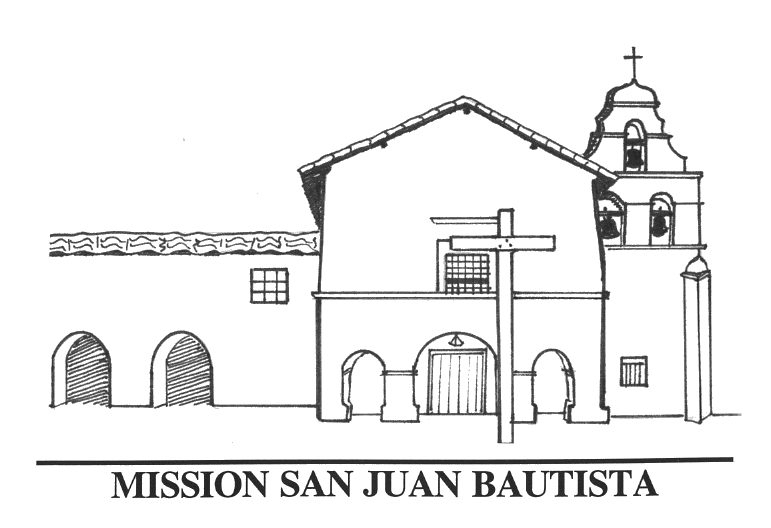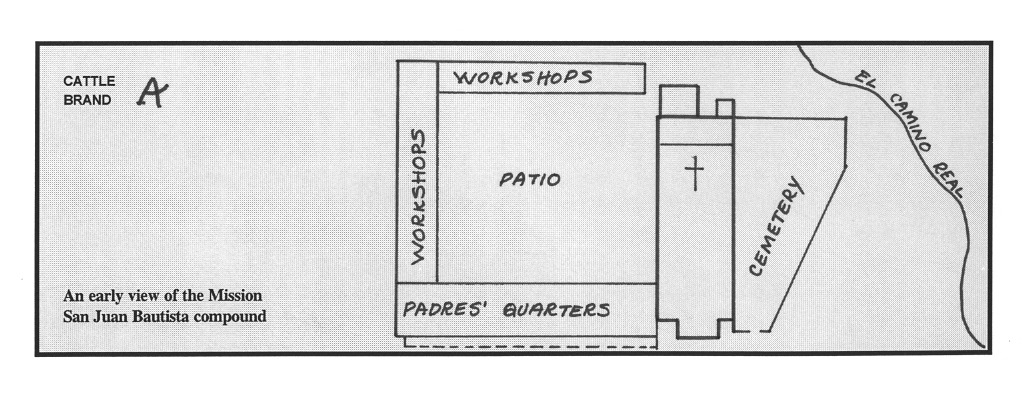| ||||
|
| ||||
|
MISSION
SAN JUAN BAUTISTA
Second &
Mariposa Street
P.O. Box 410
San
Juan Bautista,
CA
95045
Established: June 24, 1797
By: Father Fermín Lasuén, Franciscan missionary and successor to Junípero Serra as President of the missions.
Order: 15th of the 21 missions.
Location: 90 miles southeast of San Francisco, in a sunny inland valley of oak trees.
Named: In honor of St. John the Baptist, noted in the Bible as a contemporary and kinsman of Jesus. Also known as The Mission of Music.
California Historical Landmark No. 195
DESIGN OF THE MISSION
Church: 188 feet long, 72 feet wide, 40 feet high; the largest of any mission church. Made of adobe; tile roof; tile floor.
Style: Grand and large, though the front is plain except for three arches and a single square window. Three aisles, rather than one aisle, distinguish this mission church from others. Open-arched walls separate the side aisles from the main aisle. Inside walls are painted in native-style designs and bright colors by Thomas Doak, a Boston sailor who took up residence in San Juan Bautista. Some walls are painted to look like marble. Bright red drapery wall behind the altar holds statues in niches, including a life-size statue of St. John the Baptist.
Walls: Three feet thick, with cement supports.
Bell Tower: Original church had no bell tower; bells hung from a wooden crossbar in the yard. A New-England style steeple added in 1867 was destroyed in 1915; a stucco tower from 1929 was taken down in 1949. In 1976 a campanario (bell wall) in the style of other missions was erected. Of nine original bells, most have been lost. The present campanario has three bells, two of which are original. The third is a recent gift from Father Lasuén's home village in Spain.
Mission Compound: Living quarters were in a wing 230 feet long, fronted with 19 arches. Two of the arches (1st and 13th) are square instead of rounded, perhaps to allow for processions to pass through. A large kitchen had a fireplace along the entire length of the room. Also in the quadrangle of buildings were workshops for carpentry, weaving, candlemaking, and leather work.
Mission Grounds: Included 36 acres of pear and apple orchards, and many herds of animals, making this a rich mission. The farming that began under the first padres has continued to the present. Much trading of hides and tallow (animal fat used in soap and candle making) took place with the ships that put into the harbor at Monterey.

EARLY HISTORY
1786 Site was selected for a mission.
1798 Church and other buildings were completed, of adobe with mud and tule roofs.
1803 Cornerstone laid, amid much ceremony, for a larger church, needed both because of earthquake damage to the first church and because so many Costanoan Indians came to the mission. A bottle with a description of the event inside was sealed into the cornerstone of the church.
1808 Father Felipe del Arroyo de la Cuesta arrived to take charge. He convinced the builders to enlarge the church plans to include three aisles.
1812 June 23, dedication of new church. By this time, though, several earthquakes had convinced Father Arroyo to have the arches separating the aisles filled in, making a single aisle church. Father Estévan Tápis joined Father Arroyo at the mission.
1814 Town began to grow up around the mission. A plaza was laid out in front of the mission, and adobe barracks for soldiers built across the plaza.
1820 Interior painted by Thomas Doak.
1835 Mission secularized; lands taken by the government; priests continued to perform services there.
1859 55 acres of land and remaining buildings given back to the Catholic Church.
1867 Beginning of a period of extensive modernization by Father Rubio. Steeple added, interior walls and floor covered with wood.
MISSION SAN JUAN BAUTISTA TODAYThough it is built right on the San Andreas fault line, the 1906 earthquake did relatively little damage to the mission, perhaps because of Father Arroyo's filling in of the interior arches. After 1906 the buildings were strengthened with steel and concrete. Continuous use of the church has kept it from vandalism and decay. Renovators in 1949-1950 removed the stucco tower and put the bells back on a crossbar. The interior also was restored to its 1820 condition. The wall paintings done in 1820 are still bright.
Mission San Juan Bautista is an active parish church, serving a mostly Spanish-speaking community in much the same setting as in 1820. Of the mission quadrangle, only the large front wing is standing. The plaza facing the mission and the buildings around it (from the 1840's) are designated a State Historical Monument. Excavations in 1991 revealed the foundations of mission Indian housing dating from 1821 and 1824.
Renovation in 1976 opened up the arches into the side aisles. The bell wall was added. Visitors can see the restored kitchen area, and a museum with a multitude of interesting objects from the Mission's past.
The museum shows the influence of two Franciscans who spent the most years there. Father Arroyo spoke seven native dialects and compiled an index of phrases and vocabularies of the languages. Father Estévan Tápis was a musician who taught others how to read music, writing out the music notes on sheepskins so that large groups could read them easily. Also in the museum is a famous hand-organ, said to have been brought to California in 1792 by Captain George Vancouver. A story told is that a group of people attacking the mission were so charmed by the music of the hand-organ that they stopped the attack to listen.
Near the cemetery is one of the few places where a section of the old El Camino Real trail can be seen.
